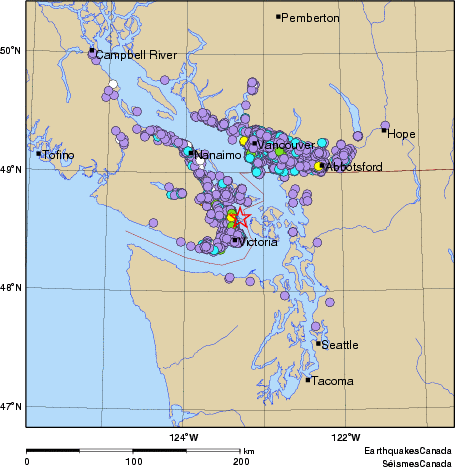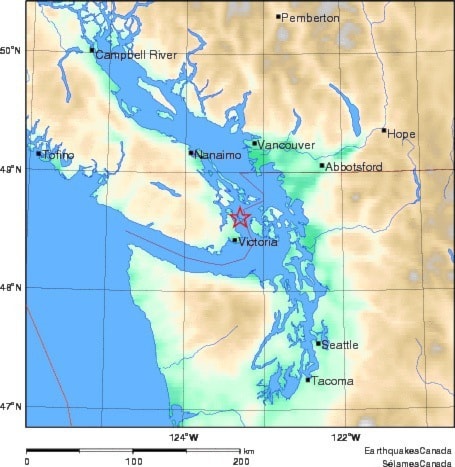Many B.C. residents were jolted awake late Tuesday night by a small earthquake that briefly rattled homes across much of Vancouver Island and the Lower Mainland.
The magnitude 4.7 quake at 11:39 p.m. was centred about eight kilometres east of Sidney, between Victoria and Vancouver, according to . (It was initially registered as a 4.3 but upgraded to 4.7 on Wednesday.)
The shaker lasted for just several seconds but stirred fears that it could just be the start of a much more serious quake, or might be followed by significant aftershocks. Neither scenario materialized. Nor was any tsunami warning issued.
Social media was deluged with individual reports of what the quake felt like, with some saying they first thought a vehicle slammed into their home.
Natural Resources Canada said it had received no reports of significant damage and none would be expected.
Many people felt their beds shake, heard dressers or windows rattle, and many small objects in homes were tipped over.
Security camera video of the quake's effects in Langley.
SFU geologist Brent Ward, who chairs the university's earth sciences department, said it was a crustal earthquake about 50 to 60 kilometres beneath the surface.
Crustal quakes are much more common and closer to populated areas than massive 8.0-plus subduction zone quakes B��Ԫ������ַ� often dubbed the Big One B��Ԫ������ַ� that strike every few hundred years well off the west coast and would cause far-reaching damage.
"Of a bigger concern are these crustal earthquakes because we get them in a much higher frequency," Ward said.
He said larger crustal quakes than last night's B��Ԫ������ַ� in the 6 to 7 range B��Ԫ������ַ� hit every 50 or 60 years in B.C. and the next one could be severe if it's closer to the surface and near large numbers of people.
"If it was only 10 kilometres deep the shaking would have been a lot more intense," Ward said.
A 7.2 crustal quake near Courtenay in 1946 caused extensive landslides, soil liquefaction and damage to brick buildings.
Ward noted B.C.'s population at risk is much larger now.
"You can imagine if we got a 7.2 earthquake underneath a populated part of Vancouver Island, there would be significant damage and there would definitely be fatalities."
When B.C. released its new earthquake response plan earlier this year it did not model its worst-case scenario on a megathrust subduction zone quake, but rather shallow crustal earthquakes directly under our big cities.
The result: an estimated 10,000 dead in Metro Vancouver, 128,000 seriously injured and 30 per cent of buildings receiving extensive damage in the event of a 7.3 magnitude crustal quake directly beneath Vancouver.
A similar scenario of a 7.0 quake beneath Victoria yielded an estimate of up to 1,500 dead and 19,000 injured.
People in different communities and neighbourhoods will feel the shaking of an earthquake differently because of the underlying material.
Ward said he didn't even wake up because there's bedrock not far below his house in Coquitlam, while his niece in Langley on loose sediment soil felt intense shaking.
"Places like Richmond, Delta and Langley B��Ԫ������ַ� areas where there's thick sediments B��Ԫ������ַ� those are going to feel the earthquake a lot more because the shaking is more intense."
RELATED:
B.C.'s quake followed a 4.4 magnitude earthquake in that is not believed to be linked.
Tuesday's tremor was the biggest quake to be felt in the Lower Mainland since a 6.8 quake rocked Washington State in 2001, causing some property damage in Seattle.
The two largest quakes ever recorded in B.C. have both been centred near Haida Gwaii B��Ԫ������ַ� an 8.1 magnitude quake in 1949 that remains Canada's strongest since 1700, and a 7.7 quake in 2012.
TransLink shut down the Expo and Millennium SkyTrain lines briefly to verify there was no damage to the rapid transit system.
No area bridges or tunnels were closed as a result of the quake. The province has at each end of the Massey Tunnel that detect the initial wave of a quake and activate signs warning drivers not to enter.
Agencies including Emergency Management B.C. are urging residents to treat the event as a wake-up call and prepare earthquake kits for the potential of a more serious quake in the future.
Everyone should have food, water and other supplies to survive 72 hours unassisted in the immediate aftermath of a disaster. are recommended for home, the workplace and your vehicle B��Ԫ������ַ� see the for details and more ideas on how to get ready.
Community Intensity Reports via Earthquakes Canada





